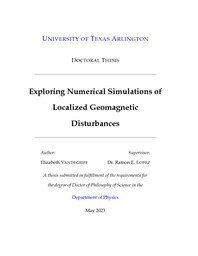
ATTENTION: The works hosted here are being migrated to a new repository that will consolidate resources, improve discoverability, and better show UTA's research impact on the global community. We will update authors as the migration progresses. Please see MavMatrix for more information.
Show simple item record
| dc.contributor.advisor | Lopez, Ramon | |
| dc.contributor.advisor | Welling, Daniel | |
| dc.creator | Vandegriff, Elizabeth | |
| dc.date.accessioned | 2023-06-14T17:05:00Z | |
| dc.date.available | 2023-06-14T17:05:00Z | |
| dc.date.created | 2023-05 | |
| dc.date.issued | 2023-05-08 | |
| dc.date.submitted | May 2023 | |
| dc.identifier.uri | http://hdl.handle.net/10106/31213 | |
| dc.description.abstract | One of the prominent effects of space weather is the formation of rapid geomagnetic field variations on Earth’s surface driven by the magnetosphere-ionosphere system. These Geomagnetic Disturbances (GMDs) cause Geomagnetically Induced Currents (GICs) to run through ground-conducting systems. GMDs can often be high amplitude and small-scale (100-500 kilometers) and we classify these as Localized GMDs (LGMDs). LGMDs are both hazardous to the power grid and difficult to predict. Modeling LGMDs is therefore a critical step for risk mitigation but is complicated due to the dynamic and sometimes highly localized nature of the phenomena. At present, global magnetohydrodynamic (MHD) models of the magnetosphere are used in forecasting space weather events, and these models can reproduce LGMDs seen in observation, but the results leave much room for improvement. This study uses a configuration of the Space Weather Modeling Framework (SWMF) model that combines three physical models: Block Adaptive Tree Solar wind Roe Upwind Scheme (BATS-R-US), an ideal MHD model of the magnetosphere; the Ridley Ionosphere Model (RIM), a shell ionosphere calculated by solving 2-D Ohm’s Law; and the Rice Convection Model (RCM), a kinetic drift model of the inner magnetosphere. For this study, we use a similar configuration used in Space Weather Prediction Center (SWPC) operations, but with a higher grid resolution which is capable of reproducing mesoscale structure in the tail and ionosphere. In the following work we present a thorough analysis of the ability of the SWMF to reproduce LGMDs in the September 7, 2017 event. Using both metrics defined in previous literature and metrics defined in this study, we quantify the success of the model against observation over the entire event. We analyze the origins of each LGMD observed in the model and examine the model for features that help us identify drivers of LGMDs. For LGMDs we cannot reproduce, we further explore the model to determine what physical processes are missing from the model that we must add in order to improve our prediction. Finally, we plan for model improvements that will have a direct effect on the ability of the SWMF to reproduce LGMDs. | |
| dc.format.mimetype | application/pdf | |
| dc.language.iso | en_US | |
| dc.subject | Space Weather | |
| dc.subject | Geomagnetically Induced Currents | |
| dc.subject | Geomagnetic Disturbances | |
| dc.subject | Magnetohydrodynamics | |
| dc.subject | Magnetospheric Modeling | |
| dc.title | Exploring Numerical Simulations of Localized Geomagnetic Disturbances | |
| dc.type | Thesis | |
| dc.date.updated | 2023-06-14T17:05:00Z | |
| thesis.degree.department | Physics | |
| thesis.degree.grantor | The University of Texas at Arlington | |
| thesis.degree.level | Doctoral | |
| thesis.degree.name | Doctor of Philosophy in Physics and Applied Physics | |
| dc.type.material | text | |
| dc.creator.orcid | 0000-0001-8851-0301 | |
Files in this item
- Name:
- VANDEGRIFF-DISSERTATION-2023.pdf
- Size:
- 12.00Mb
- Format:
- PDF
This item appears in the following Collection(s)
Show simple item record


